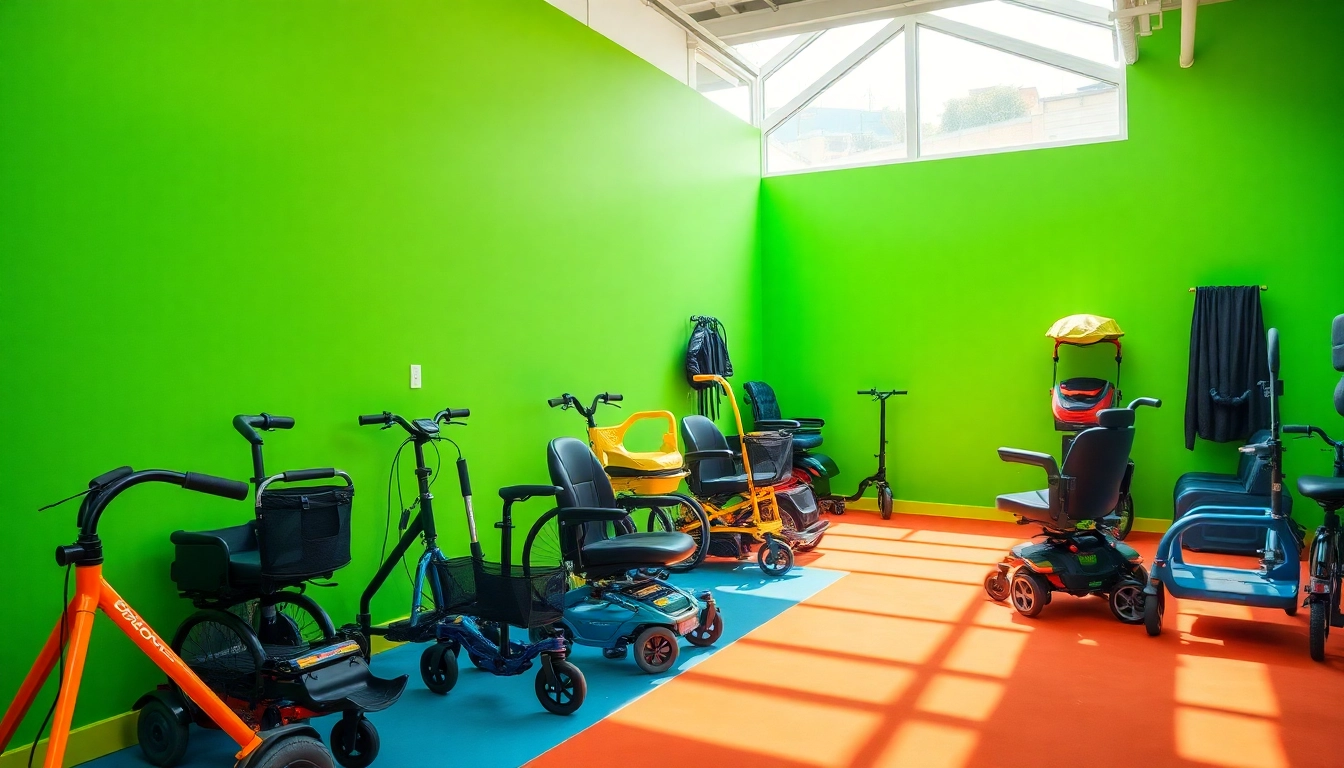
Empower Your Mobility: Essential Equipment for Enhanced Independence
Understanding Mobility Equipment
What is Mobility Equipment?
Mobility equipment encompasses a wide range of devices designed to assist individuals with mobility challenges, enabling them to move around more freely and maintain their independence. This equipment is vital for those who may struggle due to age, injury, or physical disability. From wheelchairs and scooters to walkers and canes, these tools are tailored to enhance mobility and improve the quality of life for users.
Designed with various functionalities in mind, mobility aids can be both manual and powered, allowing individuals to select the option that best suits their needs. Some common types include mobility equipment such as electric scooters, manual wheelchairs, stairlifts, and mobility scooters, each serving a unique role in enhancing user accessibility and independence.
Types of Mobility Equipment Available
There are many types of mobility equipment tailored to meet different needs and preferences:
- Wheelchairs: Available in manual and electric forms, wheelchairs can accommodate a variety of users, from those who can self-propel to those who require assistance.
- Mobility Scooters: Ideal for outdoor use, mobility scooters offer a stable platform with comfortable seating and controls that mimic a car’s driving experience.
- Walkers and Rollators: These devices provide support for users who can walk but may need stability; rollators come equipped with wheels and brakes for improved mobility.
- Canes: Simple yet effective, canes come in various styles and sizes, providing support and balance for those who need a little extra assistance.
- Stairlifts: For homes with stairs, stairlifts provide a motorized option to help individuals transition between levels safely and easily.
- Lift Chairs: These chairs assist users in standing up or sitting down, serving both comfort and practical mobility needs.
Benefits of Using Mobility Equipment
Utilizing mobility equipment can have profound effects on a person’s life. Here are some of the key benefits:
- Increased Independence: Mobility aids empower users to navigate their environments without relying solely on caregivers, leading to greater freedom and self-sufficiency.
- Improved Quality of Life: With the ability to move with relative ease, users can engage in activities they enjoy, socialize, and participate in their communities.
- Enhanced Safety: Mobility equipment reduces the risk of falls or injuries, allowing users to move confidently within their spaces.
- Better Health Outcomes: Regular mobility can contribute to improved physical health by encouraging activity and reducing the risks associated with a sedentary lifestyle.
- Customized Solutions: With a variety of equipment available, individuals can choose devices that specifically suit their physical conditions and lifestyles.
Choosing the Right Mobility Equipment
Factors to Consider When Selecting Equipment
Selecting the right mobility equipment is a critical process requiring careful consideration of multiple factors:
- Physical Needs: Assessing the user’s specific mobility limitations is paramount. Factors such as weight capacity, necessary support level, and usage environment will influence the choice.
- Usage Environment: Consider where the mobility equipment will primarily be used. Indoor use requires different features than outdoor, particularly regarding terrain adaptability and storage.
- User Preferences: The comfort and personal preferences of the user must be included in the decision-making process. Aesthetic choices, adjustability, and ease of use are significant considerations.
- Budget Constraints: Mobility equipment varies greatly in price. Establishing a budget and exploring options within that range while ensuring quality is essential.
- Durability and Warranty: Evaluate the materials and construction of the equipment. Equipment with warranties can provide added peace of mind and protection for your investment.
Comparing Different Mobility Options
With so many types of mobility equipment available, comparing options side-by-side can help clarify the best choice for a user’s specific situation. Key considerations to compare include:
- Performance: Look at how well each option meets the user’s needs in terms of speed, range (for electric devices), and ease of control.
- Portability: For users who travel or need to transport their equipment, foldable models or lightweight designs may be beneficial.
- Customization: Many manufacturers provide options for add-ons or modifications, enhancing usability for particular conditions.
- Reviews and Ratings: Customer testimonials and expert evaluations can provide insight into the equipment’s reliability and performance in real-world situations.
Consultation with Healthcare Professionals
Seeking advice from healthcare professionals is invaluable when selecting mobility equipment. Occupational therapists, physical therapists, or mobility specialists can provide personalized recommendations based on the user’s medical history and physical capabilities. These professionals can assist in evaluating:
- The appropriate type of mobility aid that aligns with medical diagnoses
- Exercises that may improve mobility and strength
- Techniques for safe operation and daily use of mobility aids
- Insurance or financial aid options available for purchasing mobility equipment
Enhancing Accessibility at Home
Adapting Living Spaces for Mobility Equipment
Ensuring a home environment is conducive to mobility equipment use is essential for maximizing safety and comfort. Common adaptations include:
- Wider Doorways: For wheelchair users, having doorways widened can facilitate easier movement between rooms.
- Ramps: Installing ramps at entrances can assist users who cannot navigate stairs, making the home more accessible.
- Clear Pathways: Keeping floors clear of obstacles and clutter helps reduce the risk of falls and allows easy navigation.
- Grab Bars: Strategically placing grab bars in bathrooms or hallways can provide additional support and confidence.
- Accessible Furniture: Selecting furniture that accommodates mobility aids—like chairs that are higher or lower—can also improve comfort and accessibility.
Common Home Modifications
In addition to general adaptations, certain home modifications can further enhance accessibility:
- Bathroom Modifications: Installing walk-in tubs or roll-in showers can make personal hygiene routines safer and easier.
- Kitchen Modifications: Lowering countertops and using pull-out shelves can aid users in meal preparation, ensuring that everything is within reach.
- Smart Home Technologies: Incorporating smart devices can assist in operating lights, thermostats, and security systems, offering users more control.
Living Independently with Mobility Aids
While mobility aids can significantly enhance independence, they also play a pivotal role in improving self-esteem and overall well-being. Users can take pride in accomplishing personal tasks, engaging in community events, and enjoying social interactions without feeling confined. Strategies to maintain independence include:
- Creating a Routine: Establishing a daily routine that incorporates physical activity can bolster mobility and confidence.
- Exploring Community Resources: Participating in local support groups or activity centers can provide both socialization and additional physical support.
- Ongoing Education: Learning about new mobility technologies, products, or techniques helps users make informed choices regarding their equipment.
Maintaining and Caring for Mobility Equipment
Regular Maintenance Tips for Longevity
Proper care and maintenance of mobility equipment are crucial to ensure safety, performance, and longevity. Here are some essential maintenance tips:
- Regular Inspections: Check the equipment for signs of wear and tear, such as fraying seats, rusted parts, or loose connections, and address issues immediately.
- Cleaning: Depending on the type of equipment, regular cleaning can prevent dirt buildup and odors. Use appropriate surface cleaners and solutions that match material types.
- Battery Care: For electric devices, maintain batteries by following proper charging habits and replacing them as recommended by the manufacturer.
- Professional Servicing: Scheduling periodic, professional maintenance checks can identify potential issues before they become significant problems.
Storing Your Mobility Equipment Properly
When not in use, proper storage of mobility equipment is essential:
- Dry Conditions: Avoid damp environments that can lead to rust or deterioration of electrical components. Store equipment indoors when not in use.
- Protective Covers: Using protective covers can shield equipment from dust and damage.
- Organized Storage: Designate a specific storage area, ensuring that equipment is easily accessible and free from obstructions.
Upgrading Your Equipment When Necessary
As needs change, it may become necessary to upgrade mobility equipment to better suit users’ current lifestyles and challenges. Indicators for an upgrade include:
- Changes in mobility status or physical condition
- Advancements in technology that provide better features or safety mechanisms
- Signs of wear that compromise the functionality of the equipment
Staying informed about new options and enhancements in mobility equipment allows users to make proactive decisions about upgrades, ensuring that they receive the best support available.
Success Stories: Real Users of Mobility Equipment
How Mobility Equipment Changed Lives
Many individuals have remarkable stories of transformation and empowerment through the use of mobility equipment. These personal narratives highlight how mobility aids have had a significant, positive impact on their lives:
- John’s Journey: After an accident left him paraplegic, John regained his independence with a custom-made wheelchair that allowed him to navigate both his home and local community.
- Mary’s Mobility Scooter: Living with severe arthritis presented numerous challenges for Mary until she acquired a mobility scooter, enabling her to visit friends and engage in her favorite hobby, gardening.
Inspiring Testimonials from Users
Users frequently express profound gratitude for the freedom mobility equipment has provided. For instance:
“Thanks to my walker, I’m able to go on morning walks with my dog again—I can’t express how much this means to me.” – Sarah, 68
“Transitioning to my powered wheelchair was a game changer. It didn’t just improve my mobility; it transformed my life.” – David, 52
Community and Support Resources Available
Community resources play a vital role in the ongoing support and care for mobility equipment users. Local disability advocacy organizations, community health services, and online forums offer guidance, resources, and social connections for individuals needing mobility aids. These platforms provide users with:
- Access to educational materials regarding correct usage and maintenance
- Opportunities for social engagement to reduce feelings of isolation
- Workshops that offer mobility training and physical support strategies
- Networking with other users to share experiences and tips



